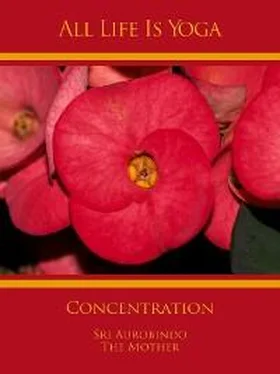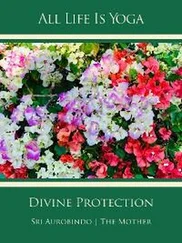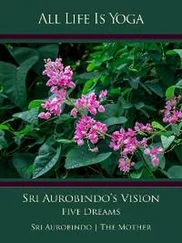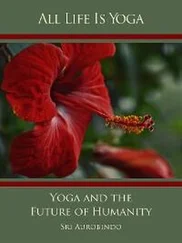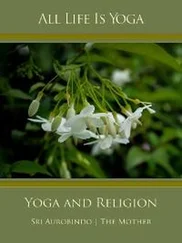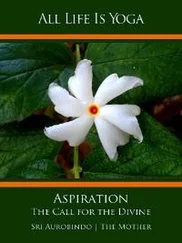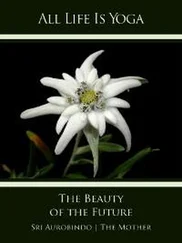Sri Aurobindo - All Life Is Yoga - Concentration
Здесь есть возможность читать онлайн «Sri Aurobindo - All Life Is Yoga - Concentration» — ознакомительный отрывок электронной книги совершенно бесплатно, а после прочтения отрывка купить полную версию. В некоторых случаях можно слушать аудио, скачать через торрент в формате fb2 и присутствует краткое содержание. Жанр: unrecognised, на английском языке. Описание произведения, (предисловие) а так же отзывы посетителей доступны на портале библиотеки ЛибКат.
- Название:All Life Is Yoga: Concentration
- Автор:
- Жанр:
- Год:неизвестен
- ISBN:нет данных
- Рейтинг книги:5 / 5. Голосов: 1
-
Избранное:Добавить в избранное
- Отзывы:
-
Ваша оценка:
- 100
- 1
- 2
- 3
- 4
- 5
All Life Is Yoga: Concentration: краткое содержание, описание и аннотация
Предлагаем к чтению аннотацию, описание, краткое содержание или предисловие (зависит от того, что написал сам автор книги «All Life Is Yoga: Concentration»). Если вы не нашли необходимую информацию о книге — напишите в комментариях, мы постараемся отыскать её.
All Life Is Yoga: Concentration — читать онлайн ознакомительный отрывок
Ниже представлен текст книги, разбитый по страницам. Система сохранения места последней прочитанной страницы, позволяет с удобством читать онлайн бесплатно книгу «All Life Is Yoga: Concentration», без необходимости каждый раз заново искать на чём Вы остановились. Поставьте закладку, и сможете в любой момент перейти на страницу, на которой закончили чтение.
Интервал:
Закладка:
And it is always the days you are a little hazy that it becomes difficult. You are hazy: as though there is something you seem to catch and which escapes you.
Naturally, if it is materially impossible – you do not have to deal with monsters! I believe your teachers are reasonable enough and if you go to them and say, “Well, I could not do it, I had no time, I did what I could, I did not have the time”, they won’t scold you, I don’t think so. But here ninety-nine times out of a hundred, it is a kind of half-inertia of the mind which makes you think that you have too much work. If you observe yourself, you will find out that there is always something which pulls this way, something which pulls that way and then this kind of haziness as though you were living in cottonwool, in the clouds: nothing is clear.
The usefulness of work is nothing else but that: to crystallise this mental power. For, what you learn (unless you put it in practice by some work or deeper studies), half of what you learn, at least, will vanish, disappear with time. But it will leave behind one thing: the capacity of crystallising your thought, making something clear out of it, something precise, exact and organised. And that is the true usefulness of work: to organise your cerebral capacity.
* * *
Chapter 1
What is Yogic Concentration
Words of Sri Aurobindo
Concentration is a gathering together of the consciousness and either centralising at one point or turning on a single object, e.g. the Divine – there can also be a gathered condition throughout the whole being, not at a point.
*
Words of Sri Aurobindo
Ordinarily the consciousness is spread out everywhere, dispersed, running in this or that direction, after this subject and that object in multitude. When anything has to be done of a sustained nature, the first thing one does is to draw back all this dispersed consciousness and concentrate. It is then, if one looks closely, found to be concentrated in one place and on one occupation, subject or object – as when you are composing a poem or a botanist is studying a flower. The place is usually somewhere in the brain, if it is the thought, in the heart if it is the feeling in which one is concentrated. The Yogic concentration is simply an extension and intensification of the same thing. It may be on an object as when one does tratak on a shining point – then one has to concentrate so that one sees only that point and has no other thought but that. It may be on an idea or a word or a name, the idea of the Divine, the word OM, the name Krishna, or a combination of idea and word or idea and name. But, farther, in Yoga one also concentrates in a particular place. There is the famous rule of concentrating between the eyebrows – the centre of the inner mind, of occult vision, of the will is there. What you do is to think firmly from there on whatever you make the object of your concentration or else try to see the image of it from there. If you succeed in this, then after a time you feel that your whole consciousness is centred there in that place – of course for the time being. After doing it for some time and often, it becomes easy and normal.
I hope this is clear. Well, in this Yoga, you do the same, not necessarily at that particular spot between the eyebrows, but anywhere in the head or at the centre of the chest where the physiologists have fixed the cardiac centre. Instead of concentrating on an object, you concentrate in the head in a will, a call for the descent of the peace from above or, as some do, an opening of the unseen lid and an ascent of the consciousness above. In the heart-centre one concentrates in an aspiration, for an opening, for the presence or living image of the Divine there or whatever else is the object. There may be japa of a name but, if so, there must also be a concentration on it and the name must repeat itself there in the heart-centre.
It may be asked what becomes of the rest of the consciousness when there is this local concentration? Well, it either falls silent as in any concentration or, if it does not, then thoughts or other things may move about, as if outside, but the concentrated part does not attend to them or notice. That is when the concentration is reasonably successful.
One has not to fatigue oneself at first by long concentration if one is not accustomed, for then in a jaded mind it loses its power or value. One can “relax” and meditate instead of concentrating. It is only as the concentration becomes normal that one can go on for a longer and longer time.
* * *
Chapter 2
Two Purposes of Concentration
Words of Sri Aurobindo
Concentration is necessary, first, to turn the whole will and mind from the discursive divagation natural to them, following a dispersed movement of the thoughts, running after many branching desires, led away in the track of the senses and the outward mental response to phenomena: we have to fix the will and the thought on the eternal and real behind all, and this demands an immense effort, a one-pointed concentration. Secondly, it is necessary in order to break down the veil which is erected by our ordinary mentality between ourselves and the truth; for outer knowledge can be picked up by the way, by ordinary attention and reception, but the inner, hidden and higher truth can only be seized by an absolute concentration of the mind on its object, an absolute concentration of the will to attain it and, once attained, to hold it habitually and securely unite oneself with it. For identification is the condition of complete knowledge and possession; it is the intense result of a habitual purified reflecting of the reality and an entire concentration on it; and it is necessary in order to break down entirely that division and separation of ourselves from the divine being and the eternal reality which is the normal condition of our unregenerated ignorant mentality.
* * *
Chapter 3
Its Prime Importance
Words of Sri Aurobindo
To change the nature is not easy and always takes time, but if there is no inner experience, no gradual emergence of the other purer consciousness that is concealed by all these things you now see, it would be almost impossible even for the strongest will. You say that first you must get rid of all these things, then have the inner experiences. But how is that to be done? These things, anger, jealousy, desire, are the very stuff of the ordinary human vital consciousness. They could not be changed if there were not a deeper consciousness within which is of quite another character. There is within you a psychic being which is divine, directly a part of the Mother, pure of all these defects. It is covered and concealed by the ordinary consciousness and nature, but when it is unveiled and able to come forward and govern the being, then it changes the ordinary consciousness, throws all these undivine things out and changes the outer nature altogether. That is why we want the sadhaks to concentrate, to open this concealed consciousness – it is by concentration of whatever kind and the experiences it brings that one opens and becomes aware within and the new consciousness and nature begin to grow and come out. Of course we want them also to use their will and reject the desires and wrong movements of the vital, for by doing that the emergence of the true consciousness becomes possible. But rejection alone cannot succeed; it is by rejection and by inner experience and growth that it is done.
* * *
Конец ознакомительного фрагмента.
Текст предоставлен ООО «ЛитРес».
Прочитайте эту книгу целиком, купив полную легальную версию на ЛитРес.
Читать дальшеИнтервал:
Закладка:
Похожие книги на «All Life Is Yoga: Concentration»
Представляем Вашему вниманию похожие книги на «All Life Is Yoga: Concentration» списком для выбора. Мы отобрали схожую по названию и смыслу литературу в надежде предоставить читателям больше вариантов отыскать новые, интересные, ещё непрочитанные произведения.
Обсуждение, отзывы о книге «All Life Is Yoga: Concentration» и просто собственные мнения читателей. Оставьте ваши комментарии, напишите, что Вы думаете о произведении, его смысле или главных героях. Укажите что конкретно понравилось, а что нет, и почему Вы так считаете.
